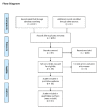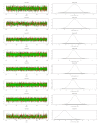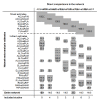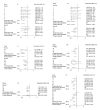Acupuncture for Diarrhoea-Predominant Irritable Bowel Syndrome: A Network Meta-Analysis
- PMID: 29977312
- PMCID: PMC5994265
- DOI: 10.1155/2018/2890465
Acupuncture for Diarrhoea-Predominant Irritable Bowel Syndrome: A Network Meta-Analysis
Abstract
Background: The objective of this study was to compare the efficacy and side effects of acupuncture, sham acupuncture, and drugs in the treatment of diarrhoea-predominant irritable bowel syndrome.
Methods: Randomized controlled trials (RCTs) assessing the effects of acupuncture and drugs were comprehensively retrieved from electronic databases (such as PubMed, Cochrane Library, Embase, CNKI, Wanfang Database, VIP Database, and CBM) up to December 2017. Additional references were obtained from review articles. With document quality evaluations and data extraction, Network Meta-Analysis was performed using a random-effects model under a frequentist framework.
Results: A total of 29 studies (n = 9369) were included; 19 were high-quality studies, and 10 were low-quality studies. NMA showed the following: (1) the ranking of treatments in terms of efficacy in diarrhoea-predominant irritable bowel syndrome is acupuncture, sham acupuncture, pinaverium bromide, alosetron = eluxadoline, ramosetron, and rifaximin; (2) the ranking of treatments in terms of severity of side effects in diarrhoea-predominant irritable bowel syndrome is rifaximin, alosetron, ramosetron = pinaverium bromide, sham acupuncture, and acupuncture; and (3) the treatment of diarrhoea-predominant irritable bowel syndrome includes common acupoints such as ST25, ST36, ST37, SP6, GV20, and EX-HN3.
Conclusion: Acupuncture may improve diarrhoea-predominant irritable bowel syndrome better than drugs and has the fewest side effects. Sham acupuncture may have curative effect except for placebo effect. In the future, it is necessary to perform highly qualified research to prove this result. Pinaverium bromide also has good curative effects with fewer side effects than other drugs.
Figures











Similar articles
-
Comparison of acupuncture and other drugs for chronic constipation: A network meta-analysis.PLoS One. 2018 Apr 25;13(4):e0196128. doi: 10.1371/journal.pone.0196128. eCollection 2018. PLoS One. 2018. Retraction in: PLoS One. 2018 Jul 19;13(7):e0201274. doi: 10.1371/journal.pone.0201274. PMID: 29694378 Free PMC article. Retracted.
-
Acupuncture and Moxibustion in the Treatment of Adult Diarrhea Irritable Bowel Syndrome: A Network Meta-analysis.Comput Math Methods Med. 2022 Jun 28;2022:9919839. doi: 10.1155/2022/9919839. eCollection 2022. Comput Math Methods Med. 2022. Retraction in: Comput Math Methods Med. 2023 Jul 19;2023:9892851. doi: 10.1155/2023/9892851. PMID: 35799631 Free PMC article. Retracted.
-
Comparison of acupuncture and pinaverium bromide in the treatment of irritable bowel syndrome: A protocol for systematic review and meta-analysis.Medicine (Baltimore). 2021 Apr 23;100(16):e25604. doi: 10.1097/MD.0000000000025604. Medicine (Baltimore). 2021. PMID: 33879727 Free PMC article.
-
[Acupuncture for diarrhea-predominant irritable bowel syndrome:a meta-analysis].Zhongguo Zhen Jiu. 2017 Aug 12;37(8):907-912. doi: 10.13703/j.0255-2930.2017.08.027. Zhongguo Zhen Jiu. 2017. PMID: 29231356 Review. Chinese.
-
[Meta analysis of acupuncture-moxibustion in treatment of irritable bowel syndrome].Zhongguo Zhen Jiu. 2012 Oct;32(10):957-60. Zhongguo Zhen Jiu. 2012. PMID: 23259285 Review. Chinese.
Cited by
-
Research Trends of Acupuncture Therapy for Chronic Pain-Related Depression or Anxiety from 2003 to 2023: A Bibliometric Analysis.J Pain Res. 2023 Dec 15;16:4301-4315. doi: 10.2147/JPR.S436434. eCollection 2023. J Pain Res. 2023. PMID: 38116394 Free PMC article.
-
The Quality of Methodological and Reporting in Network Meta-Analysis of Acupuncture and Moxibustion: A Cross-Sectional Survey.Evid Based Complement Alternat Med. 2021 Jan 11;2021:2672173. doi: 10.1155/2021/2672173. eCollection 2021. Evid Based Complement Alternat Med. 2021. PMID: 33505490 Free PMC article. Review.
-
Effects and Mechanisms of Acupuncture on Diarrhea-Predominant Irritable Bowel Syndrome: A Systematic Review.Front Neurosci. 2022 Jul 15;16:918701. doi: 10.3389/fnins.2022.918701. eCollection 2022. Front Neurosci. 2022. PMID: 35911986 Free PMC article.
-
Acupuncture for the Treatment of Depression and Physical Symptoms in Chronic Bipolar Disorder: A Case Report.Clin Med Insights Case Rep. 2020 Oct 28;13:1179547620967379. doi: 10.1177/1179547620967379. eCollection 2020. Clin Med Insights Case Rep. 2020. PMID: 33192114 Free PMC article.
-
Effects of 10.6-μm laser moxibustion and electroacupuncture at ST36 in a 5-Fu-induced diarrhea rat model.Support Care Cancer. 2021 May;29(5):2561-2569. doi: 10.1007/s00520-020-05788-0. Epub 2020 Sep 21. Support Care Cancer. 2021. PMID: 32959156
References
-
- Andrae D. A., Patrick D. L., Drossman D. A., Covington P. S. Evaluation of the Irritable Bowel Syndrome Quality of Life (IBS-QOL) questionnaire in diarrheal-predominant irritable bowel syndrome patients. Health and Quality of Life Outcomes. 2013;11, article 208 doi: 10.1186/1477-7525-11-208. - DOI - PMC - PubMed
-
- Deiteren A., de Wit A., van der Linden L., de Man J. G., Pelckmans P. A., de Winter B. Y. Irritable bowel syndrome and visceral hypersensitivity: Risk factors and patho-physiological mechanisms. Acta Gastro-Enterologica Belgica. 2016;79(1):29–38. - PubMed
Publication types
LinkOut - more resources
Full Text Sources
Other Literature Sources
Medical

